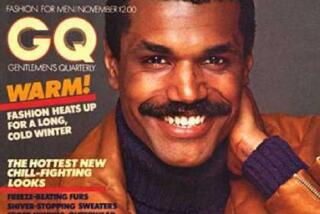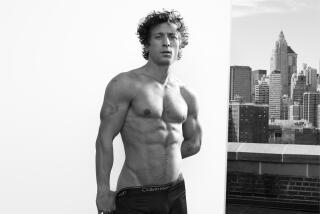Abercrombie & Fitch’s New Gay Niche: a Catalog With Wholesome Appeal
- Share via
The Abercrombie & Fitch quarterly magazine has won a place of honor on the cocktail tables of gay men from Chelsea to West Hollywood. But these gentlemen are not looking at the clothes.
Instead, they are admiring page after page of buff college boys frolicking on campus in Abercrombie & Fitch jeans, pullovers and crew necks. A posse of young men in boxers and roller-skates whoops it up at a dimly lighted rink. Half-dressed guys are pictured with their bedroom eyes staring at the reader. Four pages feature young men streaking across campus, their bare bottoms to the camera.
The images are neither physically threatening nor aggressively sexual. But to a host of readers, they are obviously homoerotic. What makes the images unique is their context. They are not in the sort of high-end fashion magazine in which homoeroticism is now commonplace, thanks to advertising campaigns from Calvin Klein, Versace, Gucci and others. They haven’t been placed in a niche publication, such as Out magazine. And they are not loaded with attitude. They are in a mainstream catalog aimed at college students, the Midwest, the middle class.
“I like it,” says Joe Landry, publisher of the Advocate. “There’s an essence of innocence that has been captured.
“As a gay person, at that age if you’re coming out, you’re fearful and shameful,” he says. “To see kids at that age, to see them being playful, happy and open--even though it’s not sexual--there’s a romance that’s captured.”
Unlike the images of muscle-bound men from the Davidoff advertisements for designer men’s toiletries or the Calvin Klein billboards, these photographs aren’t confrontational or intimidating.
“The men are idealized but not challenging,” says Harold Levine, a New York-based marketing consultant. With the Abercrombie & Fitch campaign, “a straight guy could say, ‘It could be me.’ A gay guy could say, ‘Wouldn’t that be yummy if that were my boyfriend?’ ”
The $5 quarterly catalog premiered in 1997 as the lead tool in Abercrombie & Fitch’s national marketing campaign. The current book, titled “On the Road,” has a circulation of about 1 million and has largely been credited with sparking the company’s recent huge sales increases. Total net sales in 1997 were $522 million, up 56% from the previous year.
*
The success of the catalog has not been without controversy. Earlier this year, Mothers Against Drunk Driving protested a two-page spread in the quarterly, which is aimed at the college-age market, because it featured a list of recipes for alcoholic drinks such as Sex on the Beach and Brain Hemorrhage. The company subsequently removed the pages from the magazine and issued an apology.
A spokesman says that the company has been on a mission to change its image from that of a purveyor of rugged outdoor wear to that of a more fashion-driven house. But he denies it has made a conscious attempt to court gay customers.
“People are reading into it and projecting their own sexuality on the images,” says Lonnie Fogel, director of investor relations and corporate communications. “It’s not attempting to deliberately make some sexual statement.”
Abercrombie & Fitch produced the magazine in collaboration with the New York advertising agency Shahid & Co., and the images were photographed by Bruce Weber. Shahid worked on “Chosen Families,” a controversial advertising campaign for Banana Republic that portrayed gay families in their leisure time. And while Weber is a photographer with a range of topics and styles, he is best known for his homoerotic fashion and advertising shoots for designers such as Klein.






